
スフェーン(チタン石):意味、価値、情報
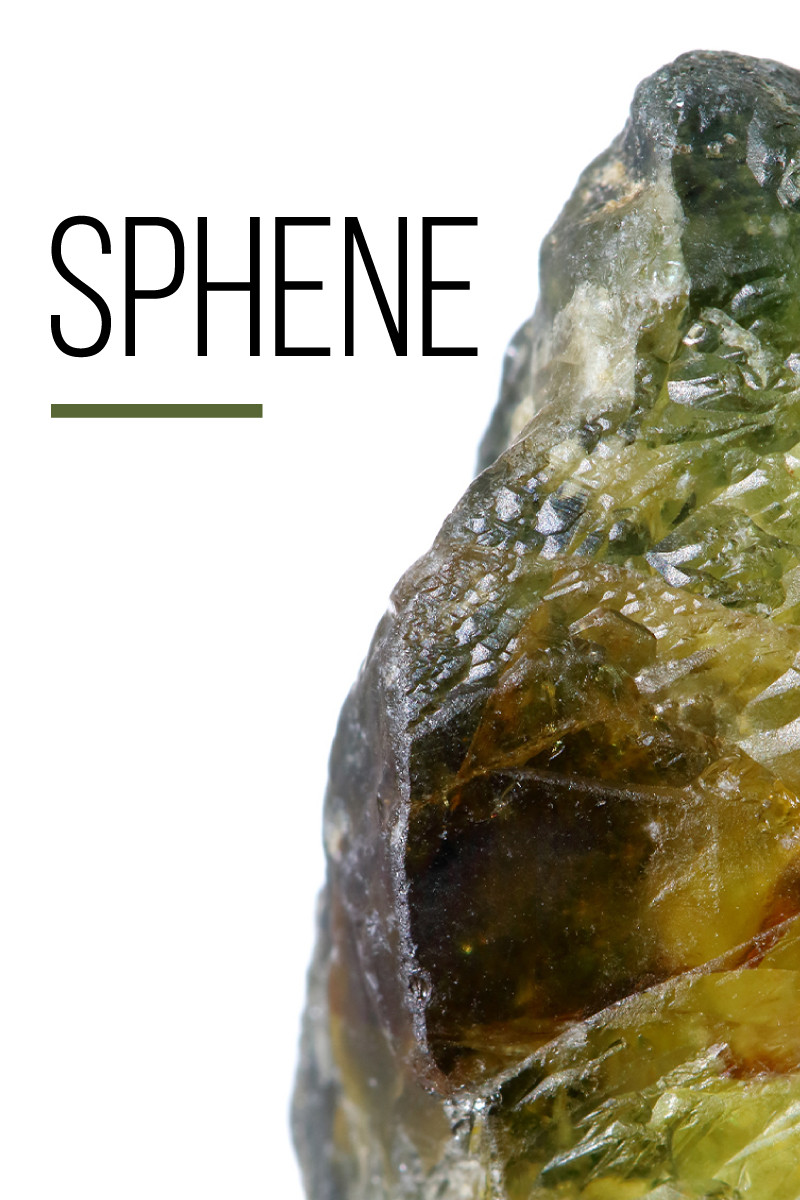 スフェーン、あるいはチタナイトは、ダイヤモンドに次ぐ光沢と、ダイヤモンドを凌駕する鮮やかな輝きを持つ、コレクターに愛される希少な宝石です。ところで、スフェーンは貴石なのでしょうか?いいえ、 半貴石です。
スフェーン、あるいはチタナイトは、ダイヤモンドに次ぐ光沢と、ダイヤモンドを凌駕する鮮やかな輝きを持つ、コレクターに愛される希少な宝石です。ところで、スフェーンは貴石なのでしょうか?いいえ、 半貴石です。
スフェーンってどんな色? 通常は明るい黄緑色ですが、無色から黒まで、様々な色があります。しかし、光に当てると、様々な色が見え、キラキラと輝く虹色の輝きも楽しめます!
スフェーンジュエリーをもうチェックしてみませんか?ぜひご参加いただき、スフェーン宝石の意味、治癒力、価格などをご覧ください。

スフェーン石とは何ですか?
スフェーンはチタン石(Titanite)という鉱物のチタン含有量の多い変種で、宝石として使用される唯一の変種です。そうです、チタン石は単なる同義語ではなく、鉱物のグループ名でもあるのです。
宝石以外に、スフェーンは何に使われますか?チタン石は顔料用の二酸化チタン鉱石として採掘されることがあります。
科学者はチタン石を地質年代測定器(放射性崩壊によって地質学の歴史を測定するための道具)や温度圧力計(岩石形成中の圧力と温度を測定する鉱物)としても利用しています。
ちょっと待ってください、スフェーンは放射性物質ですか?まあ、あるかもしれません。加工されたり研磨されたりしたものは安全ですが、原石は短期間であれば安全です。
スフェーンはペリドットのより手頃な代替品です。そのため、 8月の誕生石や16回目の結婚記念日の宝石として、ペリドットの代わりにスフェーンをお選びいただけます。スフェーン自体は、天秤座、射手座、牡牛座の星座石です。

スフェーンの仕様と特徴
スフェーンはチタンケイ酸カルシウムです。スフェーンには鉄とアルミニウムがほぼ必ず含まれており、セリウム、トリウム、イットリウムなどの希土類元素(REE)も含まれています。
REEは宝石に「放射性」の鮮やかな緑色を与えることがあります。しかし、スフェーンは通常、鉄含有量が高すぎるため蛍光を発しません。
一部のスフェーン鉱物はセリウムからメタミクト化します。メタミクト化とは、放射性物質によって結晶構造が分解され、石が非晶質になることです。
スフェーンの鉱物特性は以下の通りです。
モース硬度:5~5.5
色: 通常は黄緑、黄、緑、または茶色。無色、青、赤、灰色、または黒の場合もある。色分けが一般的。
結晶構造:単斜晶系
光沢:樹脂状~準金剛石状
透明性:透明から半透明、時には不透明
屈折率:1.84~2.11
密度:3.45~3.60
胸の谷間: 普通~良好 [110]
骨折:貝殻状
縞模様:赤みがかった白、ピンク、または白
多色性:透明な石では中程度から強い。三色性は宝石の色によって異なりますが、通常は淡黄色、オレンジがかった茶色、茶色がかった黄色です。一部の青い結晶は無色から青の二色性があります。
光学的効果: 色の変化は極めて稀
一部のスフェーンの特性 (およびタイプ) は、地域によって若干異なります。
 画像: クロムスフェーンの変種
画像: クロムスフェーンの変種
スフェーンの種類
公式のスフェーンの種類はありませんが、ショッピング中に目にする可能性のある非公式の種類を 2 つ紹介します。
クロムスフェーン:クロムによって着色された貴重なエメラルドグリーンの変種。主に米国バハ・カリフォルニア産。
カペリニャ スフェーン:ブラジルのカペリニャ産の非常に希少で高品質なライムグリーンの品種
形而上学的な観点から言えば、スフェーンの意味は何でしょうか?
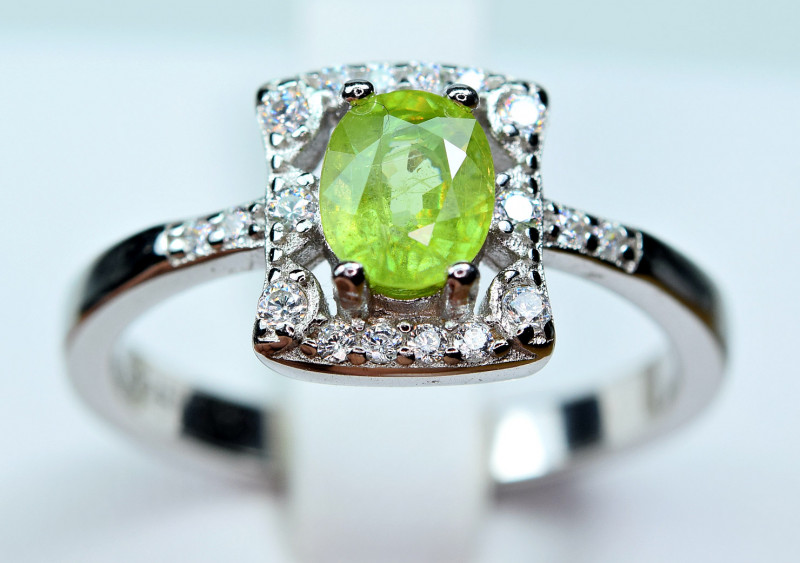
スフェーンの意味と歴史
スフェーンは知識、革新、そして神聖な光を象徴します。スピリチュアルな意味としては、霊媒師、占星術師、タロット占い師にとってお守りとして用いられます。
「チタナイト」という名称は、チタンの含有量に由来しています。「スフェーン」は、くさび形の結晶にちなんで、ギリシャ語で「くさび」を意味する「 sphenos」に由来しています。
では、なぜスフェーンはチタナイトと呼ばれるのでしょうか?簡単に答えると、鉱物学者は一般的に「チタナイト」を好み、宝石学者は「スフェーン」を好むからです。
少し長めの答えは、石の歴史と結びついています。
スイスの科学作家であり研究者でもあるマルク・オーギュスト・ピクテは、1787年にドイツのバイエルン森林地帯で初めてチタン石を発見しました。しかし、この石が初めて公式に説明され、命名されたのは1795年になってからで、ドイツの化学者マルティン・クラプロートによってでした。
1801年、著名なフランスの鉱物学者ルネ・オウイが「スフェーン」という名称を考案しました。どちらの用語も広く使われるようになりましたが、「スフェーン」の方がより一般的でした。
しかし、国際鉱物学協会(IMA)は1982年に「チタナイト」のみが正しいと主張し、「スフェーン」という名称の信頼性を失墜させました。それにもかかわらず、査読付き学術誌でさえ、著者が宝石に「スフェーン」という名称を使用することを許可しています。
次第に、「チタン石」は鉱物学ではより一般的になり、「スフェーン」は宝石学ではより一般的になりました。
どちらの名前を使っても、石には同じ治癒特性があります。これについては次に説明します。

スフェーンの治癒特性
宝石は、その色、エネルギー、そして歴史に基づいて、ヒーリングストーンとしての特別な力を持っています。スフェーンのような 緑色の宝石は、ハートチャクラのヒーリング、成功の実現、そして自然との繋がりに用いられます。
精神面では、スフェーン石は集中力、記憶力、情報処理能力の向上をサポートすると言われており、学生や研究者に推奨されることが多いです。
スフェーンクリスタルヒーリングの他の用途にはどのようなものがありますか?
身体の治癒
スフェーンの効能としては、骨折の治癒を助ける、鬱血を解消する、免疫力を高めるなどがあると言われています。
感情的な癒し
スフェーンは、感情を処理し、考えを整理し、感情の極端なバランスをとるのに役立つと考えられています。
独身生活に悩んでいる方はいらっしゃいますか?もし満たされない気持ちを抱えているなら、スフェーンは恋愛への渇望を和らげるのに役立ちます。その代わりに、ありのままの自分を受け入れ、自己愛を育む力を与えてくれます。
スフェーンの精神的な価値?確かに高いですね!でも、宝石としての価値はどうでしょうか?

スフェーン宝石の特性
他の宝石と同様に、スフェーンの価値は「4C」によって決まります。最も影響力があるのはクラリティ、カラー、カラット重量で、次にカットが続きます。しかし、これらの要素は相互に影響し合うこともあります。例えば、ボディカラーが濃いと、カットが良くても輝きが目立たなくなることがあります。
さらに詳しく知るには、まず色について見ていきましょう。
色
スフェーンの最も一般的な色は緑、黄、茶色で、特に黄緑色が最も人気があります。これらの標本の多くは、色の帯状のグラデーションを呈しています。
人気の色合いはすべて、希土類元素と鉄の量によって決まります。鉄が少ないと黄色や緑になり、鉄が多いと茶色や黒になります。しかし、最も鮮やかなグリーンのクロムスフェーンは、クロムから発色します。
稀に、アフガニスタンやパキスタン産のスフェーンが色を変える宝石として見つかることがあります。バナジウムが含まれているため、日光の下では黄緑色または緑色ですが、白熱灯の下では茶褐色がかったオレンジ色に変化します。また、黄緑色または茶褐色がかった緑色からオレンジがかった黄色に変化するものもあります。
どの色のスフェーンが最も価値が高いのでしょうか?クロムスフェーンは最も希少で、最も価値があります。一般的に、淡い色(緑、黄色、淡いオレンジなど)は、石の分散が最もよく見えるため、濃い色よりも高い価値が付けられます。
分散、あるいはファイアとは、光が石から反射して虹色に輝く現象です。言い換えれば、虹色の輝きです!スフェーンの分散度は0.051で、ダイヤモンド(0.044)を上回ります。
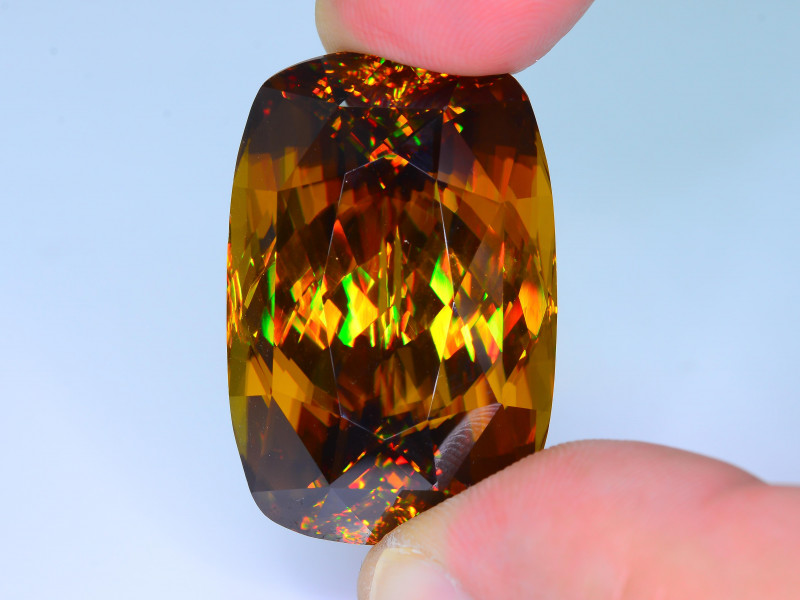
カット
スフェーンの硬度は中程度であるため、カッティングは難しい場合があります。研磨することでダイヤモンドのような輝きを出すことができますが、この工程はカッティングよりもさらに難しいです。しかし、熟練の技術を持つ者であれば、美しく輝く宝石を作り出すことができます。
スフェーンの色と同様に、カットもその分散度合いに影響を与えます。ラウンドカットやプリンセスカットのようなブリリアントファセットカットは、輝きを放つのに最適です。より暗い色や透明度が低い石の場合は、エメラルドのようなステップカットも美しく見えますが、価値はやや低くなる可能性があります。
半透明から不透明な標本は、通常、 カボション、ビーズ、または彫刻になります。
明瞭さ
スフェーンにはほとんどの場合目に見える内包物があり、タイプ III のカラー宝石の透明度グレードを与えます。
鉄、アルミニウム、希土類元素は一般的な内包物です。針状、指紋状、羽毛状、あるいは結晶が絡み合った模様などが見られることがあります。
一部のスフェーンには(特に拡大鏡で)曇りが見られる場合がありますが、これは内包物によるものではありません。スフェーンは複屈折性が高く、反射光が2つの光線に分かれる性質があります。この反射によりファセットが二重に見え、ペリドットやジルコンに似た、内部がぼやけた外観になります。
カラット重量
スフェーン宝石のほとんどは1~2カラット以下です。5~10カラットに達すると、宝石品質の透明度を持つことは稀で、5カラットを超える透明度の高いスフェーンはかなり高価になります。
産地によってスフェーンの大きさは異なり、ミャンマー産の標本の中には20カラットを超えるものもあります。インド産とマダガスカル産のファセットカットされたスフェーンは、それぞれ10カラットまたは15カラットのものが多いです。一方、ブラジル産とスリランカ産のスフェーンは、それぞれ5カラットまたは10カラット以下が一般的です。
治療
一部のスフェーンは加熱処理によって赤やオレンジ色に変化します。加熱処理は価値を下げることが多いため、販売前にその旨を開示する必要があります。
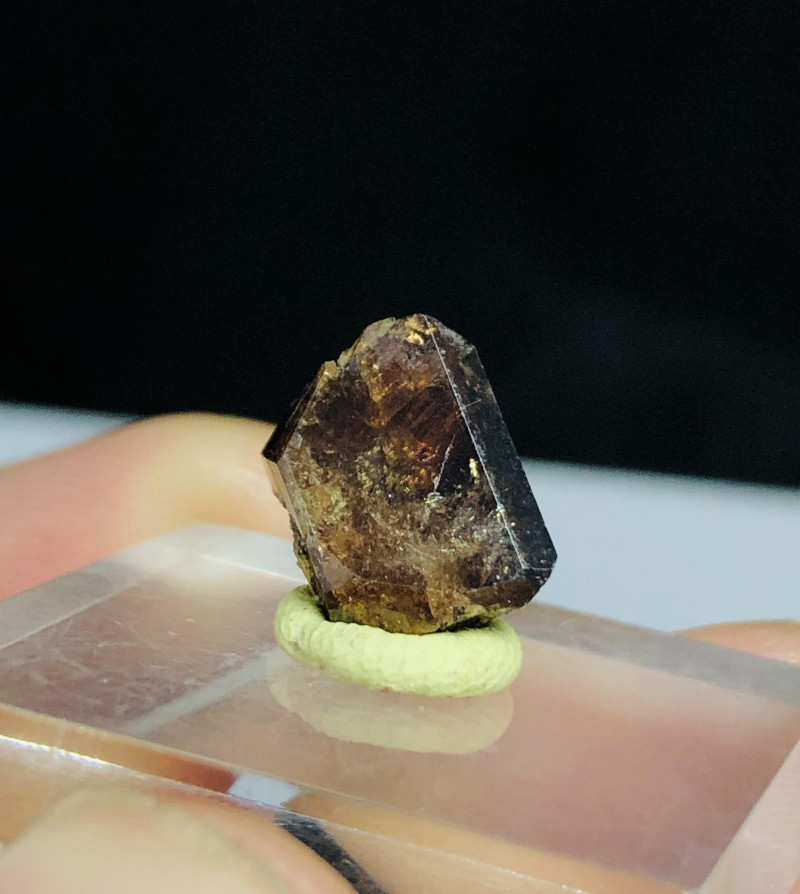
スフェーンの形成と起源
スフェーンの原石はほとんどが小さいですが、これらの微細な結晶は様々な火成岩や変成岩に分布しています。スフェーンは副次鉱物として産出され、岩石全体の1%未満を占めています。
変成岩においては、スフェーンは片岩、スカルン、片麻岩の空洞内で生成します。スフェーンを含む火成岩には、花崗岩、ペグマタイト、閃緑岩、閃長岩などがあります。
火成岩がマグマからゆっくりと冷えて固まると、他の元素を含んだ水がマグマの空洞に沈殿します。水は蒸発し、残った元素が結晶化してスフェーンとなります。
これらの火成岩は、圧力と熱、そしてミネラル豊富な水によって変成作用を受け、岩石の組成が変化します。また、この条件によって、石に含まれる一部の結晶がスフェーンに変化することもあります。
採掘場所
スフェーンの主な産地は北米とマダガスカルです。多くの地域が、それぞれの地域特有のスフェーンで知られています。以下に、スフェーンの産地と、その産地で知られているスフェーン(該当する場合)をすべてリストアップします。
アフガニスタン(一部色が変化)
ブラジル(多くの場合透明、双晶構造、黄色から緑色、複屈折なし、カペリニャスフェーン)
カナダ(黒と茶色)
中国
インド(緑、黄、茶色。世界最大かつ最も明るいもののいくつか)
イタリア
マダガスカル(黄色から緑色、双晶、透明、時には大きい、複屈折が低い)
メキシコ(クロム、茶色、黄褐色、最大4インチ、高複屈折)
ミャンマー(時には大きい)
パキスタン(一部色が変わる)
ロシア
スリランカ(蜂蜜色、濃い茶色、黄緑色、最も高い複屈折)
スイス
アメリカ合衆国(アラスカ、メイン、ニューヨーク、カリフォルニア - クローム)
入手先はさておき、価格は購入の大きな要素です。スフェーンの販売価格はどれくらいになるでしょうか?
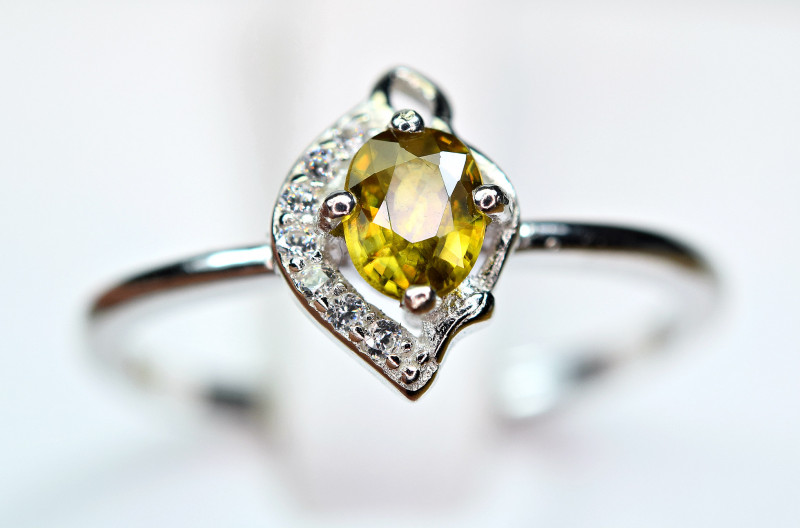
スフェーン宝石の価格と価値
スフェーンの価格はトルマリン宝石と同様にかなり手頃です。最も高価なのは、ファセットカットされたスフェーンで、分散性に優れ、鮮やかな発色と非常に高い透明度を誇ります。
小売価格帯では、ファセットカットされたスフェーン宝石の約50%が100ドルから1,000ドル、次いで20%が50ドルから100ドル、15%が20ドルから50ドルとなっています。これらの小売宝石の約75%は1カラットから5カラットです。
卸売価格はさらに低くなりますが、その内訳は以下に記載します。
全体的に見て、分散性に優れたファセットカットのクロムスフェーンが最も高価で、卸売価格は1~10カラットで1カラットあたり50~600ドル、20カラットを超えると1カラットあたり200~1,000ドルです。ファセットカットのカラーチェンジクロムスフェーンは1カラットあたり約190~475ドルです。
残りの色のファセットカット宝石の1カラットあたりのスフェーンの価格は次のとおりです。
色が変わるもの:1カラットあたり190~475ドル
黄色:1カラットあたり70~320ドル(ただし、1カラットあたり650ドルに達するものもある)
黄緑色:1カラットあたり30~70ドル
グリーン(クロム以外) : 1カラットあたり30~250ドル
オレンジ:1~10カラットの場合、1カラットあたり50~75ドル
さて、スフェーンカボションの価格は次のとおりです。
色が変わるもの:1カラットあたり80~120ドル
黄色:1カラットあたり1~40ドル
グリーン:1カラットあたり5~60ドル
ブラウン:1カラットあたり0.30ドル~9ドル
最後に、スフェーン原石があります。これは 1 カラットあたり 0.15 ~ 5 ドルですが、まれに 1 カラットあたり 20 ドルに達するものもあります。
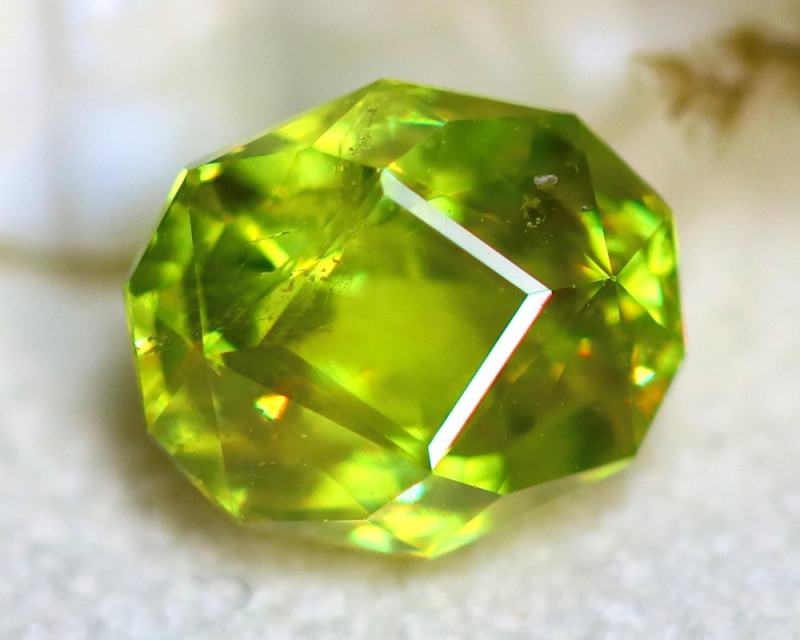
スフェーンのケアとメンテナンス
スフェーンを安全に保つための宝石の手入れについて説明する前に、あなた自身の安全を守るための放射線の側面について説明しましょう。
加工または研磨された作品は安全に取り扱っていただけます。スフェーンは放射能が弱いため、生の標本は短時間であれば安全に取り扱っていただけます。
石の硬度はかなり低く、脆いので、スフェーンリングのような壊れやすいジュエリーを選ぶことはお勧めできません。
スフェーンのネックレスやイヤリングなどのジュエリーは、保護セッティングを施したり、たまにしか着用しないことで、より安全に保護することができます。さらに、イヤリングやペンダントは光を捉え、その鮮やかな輝きを放つのに最適です。
スフェーンの洗浄には、ぬるま湯と中性洗剤をつけた柔らかいブラシのみを使用してください。超音波洗浄機やスチームクリーナーは使用しないでください。
スフェーンを以下の場所に置かないでください:
熱
酸
過度の発汗
激しい衝撃
その他の宝石(別々に保管)

これまでに見たことのない「スフェーン」のような宝石をお探しですか?
チタン石と呼ぶかスフェーンと呼ぶかはあなた次第ですが、一つ確かなのは、この宝石はどんなコレクションにも飾っておいて損はない、あるいはゴージャスな服装を引き立てる素晴らしい宝石だということです。
素朴なボヘミアン風のブラウンのペンダントから、この世のものとは思えないほど鮮やかなグリーンのイヤリングなど、どんなスフェーンでも注目を集めること間違いなしです。
Gemstone Encyclopedia検索
最新記事
ヤシ象牙彫刻は、植物象牙とも呼ばれ、南米のヤシ科植物フィテレファス属のヤシの実から倫理的に採取された、象牙の天然代替品です。このガイドでヤシ象牙についてすべて学びましょう!
15th Jan 2026
レインボーラティスサンストーンは、様々な内包物によって3つのゴージャスな光学的効果を持つ長石の一種です。燃えるように鮮やかな色合いと格子模様が、コレクターにとって希少な宝石となっています。
12th Jan 2026
記事のカテゴリ
How To's is where you will find helpful articles from gem Rock Auctions on how to cut gemstones, select gemstones and buy gemstones.
9記事数

